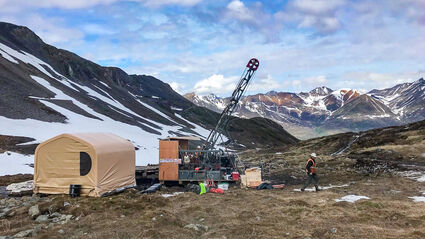Drills testing Saturn porphyry deposit
North of 60 Mining News – August 9, 2019
Last updated 9/26/2020 at 5:20am

Kyle Negri, Millrock Resources Inc.
PolarX' 2018 drilling east of the Zackly skarn deposit at Alaska Range cut strong copper and gold mineralization with veining and alteration commonly associated with porphyry systems, providing further evidence that the Australian exploration company was vectoring toward a porphyry body at Saturn.
PolarX Ltd. Aug. 6 reported that initial data from an induced polarization (IP) geophysical survey over the Saturn target at its Alaska Range project has identified large anomalies which are consistent with the porphyry copper‐gold mineralization being targeted by drilling that is now underway.
Funded by an A$4.3 million investment by Lundin Mining Corp. in June, this 5,000-meter drill program is expected to include eight to 10 deep holes.
PolarX identified Saturn as a potential porphyry copper‐gold target after evaluating aeromagnetic data early last year, and this confirmed through a higher‐resolution survey in October 2018.
Saturn is approximately 3,000 meters east of the high‐grade Zackly skarn deposit, a style of mineralization often associated with large mineralized porphyry systems.
The Saturn anomaly is interpreted to be the potential fluid source for the east‐west trend of skarn mineralization and alteration discovered at Zackly.
Skarn deposits are formed when mineralized fluids come in contact with rock packages that are usually carbonate-rich, which causes the metals to precipitate out and form a particularly high-grade mineralized body. Porphyries, on the other hand, are formed at the center of the mineralizing event that created the skarn. Because there is not a catalyst that concentrates the minerals, porphyries tend to be lower grade but much larger.
Porphyry deposits currently account for more than half of global copper production and are an increasingly important source of this useful metal. In addition to copper, porphyries tend to carry gold, molybdenum, rhenium and other metals.
The Saturn anomaly is interpreted to be the potential porphyry fluid source for the east‐west trend of skarn mineralization and alteration discovered at Zackly.
The magnetic body that first provided evidence of a potential porphyry body at Saturn lies under 10 to 15 meters of glacial sediments deposited on top, which covers any visual or geochemical clues on the surface.
The geological and geophysical evidence, however, is very compelling.
This evidence is being bolstered by initial results from ground-based IP geophysics data along six lines, three running east-west and three running north-south. Collection of data along the east-west lines is complete, and areas of anomalous chargeability have been identified on all three sections.
In each case the highest chargeability surrounds a zone of elevated chargeability associated with the magnetic highs. PolarX said this pattern is consistent with the classic porphyry copper exploration model and further confirms the interpreted porphyry intrusion as a high priority drill target.
The first two holes to test this porphyry potential at Saturn, 19SAT001 and 19SAT002, are currently underway.
Planned to be drilled to down‐hole depths of at least 600 meters, these holes will test the core of porphyry mineralization indicated by the IP chargeability response and magnetic bodies. PolarX anticipates it will take roughly two weeks to complete these holes with the two rigs onsite.

The balance of the drilling at Saturn will be targeted after the geology encountered in these two holes is assessed and combined with the magnetic and IP data. The remainder of the IP survey is expected to be completed within two weeks.
–SHANE LASLEY





Reader Comments(0)